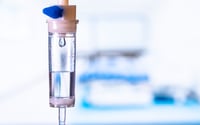Ketamine Comparable to ECT for Patients With Refractory Depression Without Psychosis

Ketamine is about as effective as electroconvulsive therapy (ECT) at reducing depressive symptoms in patients with treatment-resistant depression, according to a study published this week in The New England Journal of Medicine. These findings were also discussed during a session on Wednesday at APA’s Annual Meeting in San Francisco.
For decades, physicians have recognized ECT as an effective and fast-acting treatment option for people with refractory depression, lead study investigator Amit Anand, M.D., of Brigham and Women’s Hospital in Boston, told Annual Meeting attendees during his presentation of the data.
However, as he and colleagues wrote in the NEJM paper, “ECT remains underused owing to limited availability, social stigma, and concerns regarding the adverse effect of cognitive impairment. … Ketamine is an attractive alternative for patients [with treatment-resistant depression] because it does not require general anesthesia and is not associated with clinically significant memory impairment.”
To compare these two treatments, Anand and colleagues recruited adults aged 21 to 75 who had been referred by their clinical providers for ECT. The participants met the criteria for a DSM-5 diagnosis for major depressive disorders without psychotic features. All participants were required to have a score greater than 20 on the 60-point Montgomery–Åsberg Depression Rating Scale (MADRS), indicating moderate to severe depression, and to have failed to respond to at least two adequate trials of antidepressant treatment.
A total of 403 patients from five clinical sites across the country were randomly assigned to three weeks of ECT (right unilateral ultrabrief) thrice weekly or ketamine (0.5 mg per kilogram of body weight over 40 minutes) twice weekly. For both treatments, clinicians could use their judgement to adjust the ECT electrode placement/ketamine dose or end treatment early. Participants were allowed to continue to take previously prescribed medications throughout the trial. The primary outcome was patient-reported treatment response, defined as at least a 50% decrease on the 16-item Quick Inventory of Depressive Symptomatology–Self-Report (QIDS-SR).
“This trial was designed to be pragmatic and mimic what is going on in real-world clinics,” Anand said during his presentation. “The practitioners’ goal was to try and get the patients better as they normally would.” Anand added that the choice of the QIDS-SR as the main outcome reflected an approach to test which treatment patients thought was better.
After three weeks, 55.4% of participants in the ketamine group and 41.2% in ECT group reported a response to treatment, according to the QIDS-SR. Similarly, the clinician-rated MADRS scale suggested that 50.8% in the ketamine group responded to the treatment and 41.1% responded ECT. Ketamine was also associated with slightly higher remission rates on both the QIDS-SR and MADRS.
The participants receiving ECT reported greater problems with memory at the end of treatment compared with those who received ketamine, though by the one-month follow-up, there was little difference between the two groups. Among other side effects, ECT participants reported more musculoskeletal adverse effects, whereas ketamine participants reported more dissociation symptoms.
To read more on this topic, see the Psychiatric News article “Why Are Psychiatrists Hesitant to Refer Patients For Interventional Treatments?”
(Image: iStock/georgeoprea9)





